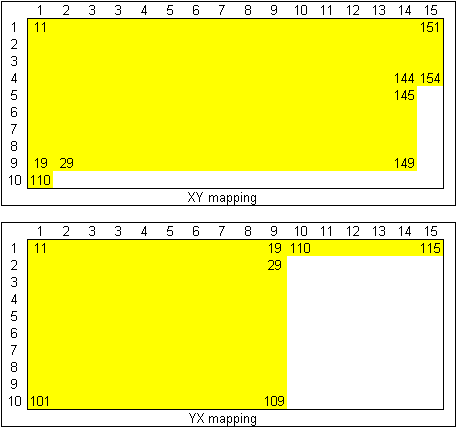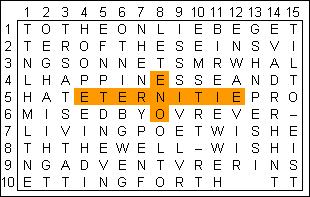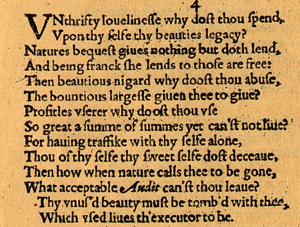|
Take what you have gathered from
Coincidence
— Henry Neville — Appendix A – update Two interesting years
from an unsolicited email
Introduction
In January, 2009 James Goding and Bruce Leyland published Version 1 of their hypothesis that Henry Neville wrote the works attributed to William Shakespeare. In April 2009 Drystone commented on the material in that publication and on the work of Brenda James. In July 2011 Goding and Leyland published Version 20 of their hypothesis. In July 2012 they published Version 33 of their hypothesis. This page reviews Version 20 and Version 33.
Version 20
Goding and Leyland present Version 20 as an interactive PowerPoint. The PowerPoint presentation is organised around the Goding and Leyland 15 column grid setting of the dedication to the sonnets. The foreground material is supplemented with internal links to auxiliary comments and data. The data includes the relevant sonnets. The arrangement works well. The principal differences in content of the current version to earlier versions:
The dynamic nature of the PowerPoint presentation results in referencing difficulties for a critic. There has not been a sufficient change in content to require revision of work previously published on this site. Drystone's reservations about the dedication-sonnet pointers are threefold:
There are more than twenty sonnets referenced in the Goding and Leyland document. Drystone does not intend to discuss each case. The evaluation of the material is subjective, and the reader will decide upon its worth. Drystone illustrates a few points that the reader might like to consider.
1) The pointers are very tenuous and open to alternative interpretation.
2) The material thus discovered within the sonnets is open to alternative interpretation.
3) Much of the decrypted material does not relate to the hypothesis of Neville as author of the sonnets. Consider for example the pointer formed by the "two TENs (that) intertwine with HENRY and intersect at
T." The T generates a pointer to Sonnet 38. (It could have just as validly been said to point to Sonnet 83.) Sonnet
38 contains, we are told, two TENs. Well actually it contains one TEN and one TENTH. Goding and Leyland observe that Sonnet 6
contains five TENs. This count game is interesting, perhaps, but it is not relevant to the Neville-as-author hypothesis.
Mapping to the sonnets
Because James Goding and Bruce Leyland make extensive use of a coordinate system to map or point from their decryption grid to particular sonnets, the process warrants some discussion. 
After arranging the dedication into 15 columns, Goding and Leyland number the columns left to right 1 to 15 and the rows top to bottom 1 to 10. The position of any character in the grid can be specified by its coordinates (column position, row position). For example, the third letter in the second row is at coordinates (3, 2). The ordering of the coordinates, column followed by row, is consistent with standard mathematical practice. The next step in their process is to drop the intervening comma and concatenate the two coordinates to produce a single number. Thus (3,2) translates to 32. This number is used as a pointer to a particular sonnet, in this example, Sonnet 32. Mathematically the concatenation process is nonsense; however, that does not preclude it from being used as an encryption technique. The top diagram shows how positions on the grid map to particular sonnets. Sonnets 1 to 10, 20, 30, 40, 50, 60, 70, 80, 90, 100, 120, 130, 140 and 150 are excluded from the process. With the exception of the first position none of the characters in the last row map to any of the sonnets. For example, the second character in the last row attempts to map to the non-existing Sonnet 210. Goding and Leyland also use an alternative method – the coordinates are reversed before they are concatenated. Thus, when this method is applied, (3, 2) becomes a pointer to Sonnet 23. The first method is referred to as the XY method, the second as the YX method. The scope of the YX method is shown on the lower diagram. Sonnets 1 to 10, 20, 30, 40, 50, 60, 70, 80, 90, 100 and 116 to 154 are excluded. The 23 sonnets that are excluded from both methods are 1 to 10, 20, 30, 40, 50, 60, 70, 80, 90, 100, 120, 130, 140 and 150. Goding and Leyland propose a rule to determine which method of mapping is applicable in a particular case. If a decrypted word reads left to right or top to bottom, the XY form of pointer is used. Goding and Leyland explain "However, NEVILLE, TT and TEN ... the only words that read right to left have [reversed] coordinates." Drystone does not find it that straightforward. Consider, NEVILLE does not appear anywhere in the Goding and Leyland grid as a decrypted word. (Actually Drystone has found two complete NEVILLEs in another grid, DS115.) NEV appears twice in their grid, once reading top to bottom and once reading right to left. The V is common to both NEVs. (Drystone regrets that for clarity of discussion Goding's and Leyland's presentation does not accommodate referencing.) Goding and Leyland, applying their rule, use each of the Ns to provide a pointer to a sonnet. In addition they use the V as a pointer to another sonnet. However, depending whether you view the V as part of NEV or part of VEN, then either the XY and YX method can be legitimately applied. Goding and Leyland select the YX method, presumably because it gives a suitable answer. (The same ambiguous situation occurs with the T that is common to NET and TEN.) TT stands, we are told, for twenty-two (when it's not π, pi). It's not clear why Goding and Leyland nominate TT as reading right to left rather than left to right. In the case of L(')ETE pointing to Sonnet 18 the rule has been applied incorrectly (and acknowledged). The situation for the sequence ELL is very confused. In a further case (the Y in HENRY) the rule is applied and then not applied resulting in two sonnet pointers for a single letter. There is a lot of scope for creative sonnet selection in a freely interpreted coordinate decryption system
Sonnet 116
Let me not to the marriage of true mindes
Admit impediments, love is not love Which alters when it alteration findes, Or bends with the remover to remove. O no, it is an ever-fixed marke That lookes on tempests and is never shaken; It is the star to every wandring barke, Whose worths unknowne, although his higth be taken. Lov's not Times foole, though rosie lips and cheeks Within his bending sickles compass come, Love alters not with his breef houres and weekes, But beares it out even to the edge of doome: If this be error and upon me proved, I never writ, nor no man ever loved. It seems that all roads lead to Sonnet 116. Bond (the de Vere proponent) finds his way there because he discovers ROSIE LIP (sic) in one of his grids. Goding and Leyland find a pointer to the sonnet in their grid. We are all agreed that Sonnet 116 has more instances of the letter sequence "ever" than any other sonnet. (One wonders if the author of the sonnets, without access to a word processor with a search function, was aware himself of the many amazing facts about his own work.) This multiplicity of "ever" delights Bond because "vere" is an anagram of "ever". It also delights Goding and Leyland because the pointer that leads to Sonnet 116 is generated by the initial E in EVER-LIVING. Remarkably the final line of Sonnet 116, it is explained, supports both the de Vere and the Neville case. Bond finds de Vere in it; Goding and Leyland find Neville in it. Drystone (and here I find myself momentarily caught up in the chase ;-) finds it surprising that Goding and Leyland do not remark on the second quatrain.
O no, it is an ever-fixed marke
That lookes on tempests and is never shaken; It is the star to every wandring barke, Whose worths unknowne, although his higth be taken. The permanent mark that is unaffected by storm and provides a navigation aid to shipping (bark = barke = barque = a small ship that rhymes with marke) is the north pole star. I guess its worth is unknown in the sense that it is beyond evaluation. Its (angular) height above the horizon would have been taken with the Elizabethan form of a sextant. From this measurement a traveller can determine his latitude. (He will have to wait another 150 years for John Harrison to invent the chronometer if he is to determine his longitude.) Incidentally, Julius Caesar was also aware of the pole star:
But I am constant as the northern star,
Of whose true-fixed and resting quality There is no fellow in the firmament. Act III, Scene I, This navigation material is relevant because Neville, we understand, majored in astronomy at Oxford.
Getting technical
Goding and Leyland write: 'Sonnet 79 is one of only two sonnets (146 is the other) that features "en" in two rhyming couplets.' (Aside: it is evident from examination that the rhyming pattern of a Shakespearian sonnet is abab cdcd efef gg – that is, three quatrains (COD) and a couplet (COD). Hence there cannot be 'two rhyming couplets' in a sonnet. As an aside on aside, Sonnet 126 consists of six rhyming couplets – is it really a sonnet?) It is not clear what Goding and Leyland intend by the description 'features "en"'. Sonnet 79 has the rhymes pen/againe and argument/invent. Sonnet 146 has the rhymes spend/end and men/then. Moreover Sonnet 105 has the rhymes excellence/difference and argument/spent. Does it feature "en" in these two rhymes?
Version 33
In July 2012 James Goding and Bruce Leyland published Version 33 of their analysis of the dedication to Shakespeare's Sonnets. It is an interactive Power Point presentation as was version 20. As before he dynamic nature of the PowerPoint presentation results in referencing difficulties for a critic. The variation from Version 20 is not extensive. Some significant changes are addressed here.
A concept dismissed
In Version 20 of their work Goding and Leyland proposed that the signature T.T. to the dedication and the TT displayed in the grid could be viewed as the Greek letter pi, π. Then since pi can be taken as 22/7 they noted:
However, pi does not equal 22/7. Simply, 22/7 is sometimes a workable approximation. In fact, pi cannot be expressed as the ratio of two integers. This fact annoyed the Greeks no end as they were great believers in the harmony of numbers and ratios. They declared that pi was an irrational number. (By the way, another common irrational number is the square root of two, which can be bought by the ream from office supplies – it is the basis of the A series paper sheet sizes.)
Drystone pines over the absence of pi from Version 33. The concept of the dedication being signed off by an irrational entity was attractive.
A concept introduced
In Version 33 of their work Goding and Leyland introduce a new concept, the ideational pun. An ideational pun, Goding and Leyland tell us, "is an interplay between an idea and a word that could – but does not – express or relate to that idea ... but the word itself does not appear". Drawing from that definition Drystone ideates that:
Ideational puns are important to the Goding and Leyland hypothesis because they add to the evidence that there are deliberate coded links between the dedication and the sonnets. The extent to which their aim is achieved is a matter of judgment for the reader.
Dot points
Well, um, not really. The extracts on the right,'joy delights in joy' and 'injoy it', are from Sonnet 8 and Sonnet 9 respectively. It is clear that in the alphabet used for the Sonnets, the typeset representations of i and j were the same and dotted.
Drystone decodes
Return to Henry Neville Index
 ONE ETERNITIE
ONE ETERNITIE
Preconceptions aside, the dominate objects in the 15 column grid are the centrally placed word, ETERNITIE, and its bisector,
the vertical word ONE. (Note in the grid to the right, simply for convenience, the "MR space" of the Goding and Leyland grid has been represented as "M R". The rest of the grid is unaffected by this change. Incidentally the ONE ETERNITIE presentation is the same in the Bond version of the 15 column grid (DS122)). The word ETERNITIE starts at column 4 and finishes at column 12. The word ONE starts at row 6 and finishes at row 4. If there is a relationship between the 15 column grid and the numbered sonnets it will involve the numbers 4, 12, 4 (again) and 6. The mapping between these numbers and the sonnets is not, of course, unique – there are several possibilities. Some degree of experimentation will be required to decipher the code. The expectation is that the encoder will have embedded further clues so that we will become aware that we have reached the correct solution.  Sonnet 126
Sonnet 126
 Sonnet 4
Sonnet 4
 Sonnet 49 (lines 1 – 4 of 14)
Sonnet 49 (lines 1 – 4 of 14)
Drystone proposes that the ONE ENTERNITY message is directing us to the two sonnets – 4 and 126. Sonnet 126
By the standard definition, 126 is strictly not a sonnet at all as it is two lines short of the nominal fourteen. Bracketed empty lines
after line 12 indicate that the abbreviated length is deliberate. The standard form of a sonnet is three quatrains and a couplet,
however, this sonnet consists of 12 lines formed from 6 couplets – thus the sonnet has the remarkable feature that its number, 126,
describes its structure. The sonnet tells of the beauty of youth aging. It speaks of the "fickle hour" and "wretched minutes." The moral is that there may be fickle hours and wretched minutes, however there is but one eternity. Perhaps not a pun, but certainly a ideational link between the message and the sonnet. Sonnet 4Now that the numbers 12 and 6 derived from the ONE ENTERNITY message have been allocated, the numbers 4 and 4 (again) remain. So why has Drystone selected Sonnet 4 rather than, say, Sonnet 44? Why discount the repeated 4? An examination of the sonnets 126 and 4 uncovers the determining factor. Each sonnet contains the word "audit", and in each case it is presented in italics and with the initial letter capitalised. There is no other sonnet where audit is presented in such a way. Audit appears in sonnet 49, but it is not in italics and does not start with a capital letter. This is the clue the encrypter has provided. The sonnets we seek are indeed sonnets 126 and 4. The process that started with the observation of the dominant words in the grid and resulted in identifying the two sonnets is very tight. CommentOf course Drystone doesn't believe a word of it. Drystone's plan was to find a route to its favourite sonnet, Sonnet 4, (DS26, DS166 and DS204). The mission was particularly successful, because as a consequence of the "audit" link, even the desired quatrain within Sonnet 4 was highlighted. Drystone's aim was to illustrate the Drystone contention that there are sufficient mechanisms (and the sonnet 126/4 exercise used only a few) available in the Goding and Leyland process to achieve whatever outcome is required to support a nominated argument. Last update March 22, 2020 Mal Haysom initial posting 29/03/2009 |
 Goding and Leyland explain that "i is the only dotted letter in the Elizabethan alphabet." [Version 33, approximately slide 24]
Goding and Leyland explain that "i is the only dotted letter in the Elizabethan alphabet." [Version 33, approximately slide 24]